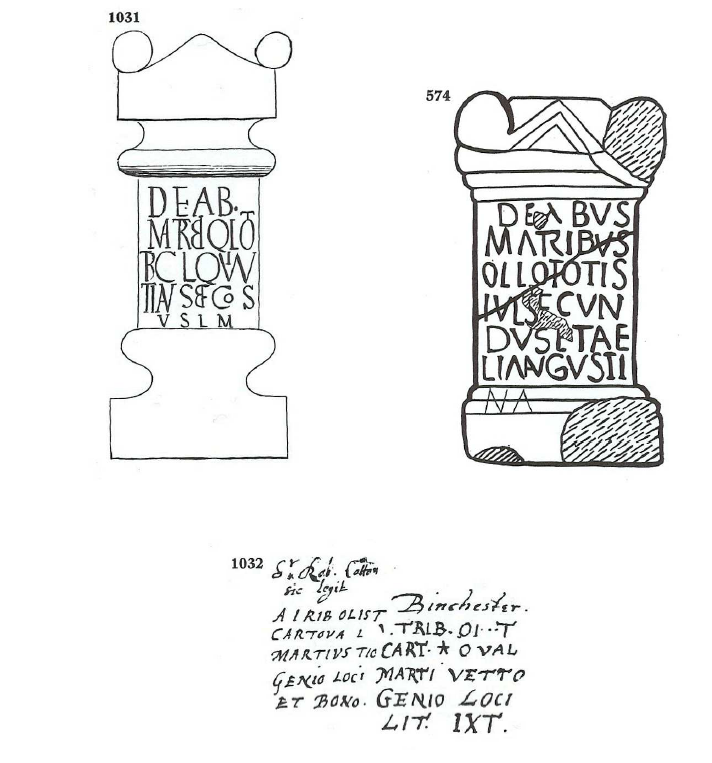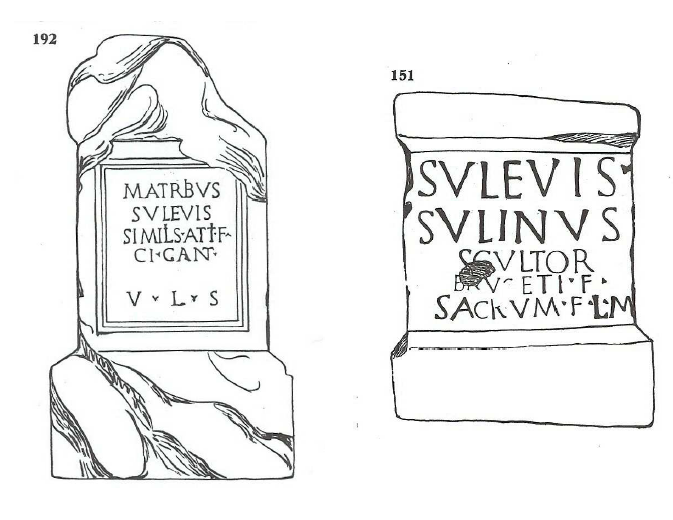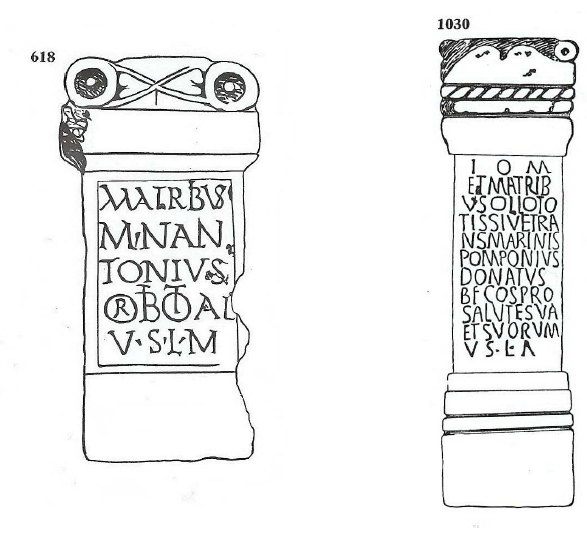C) The ‘Mothers’ in Britain
In Britain, the dedications to the Matres amount to approximately fifty inscriptions, all but a few from military sites, notably along Antonine’s and Hadrian’s Wall, and dedicated by soldiers. One of the few exceptions is the inscription to the Matres Ollototae, which is from the non-military site of Heronbridge, Cheshire.184 This suggests that the cult of the Matres and Matronae was brought to Britain by auxiliary troops from the Continent, such as by the Germanic legionaries of the Roman army.185 However, it does not mean that the Celtic peoples from Britain did not have any cultural notions of the Mother Goddesses, only that some particularities in the worship must have come with the army.
The cult of the Mothers in Britain is clearly Romanized, for they all bear Roman epithets, such as Transmarinae, Campestres, Domesticae or Fatae,186 apart from the Matres Ollototae and the Matres Suleviae. The Matres Ollototae are undeniably Celtic, for their name is composed of Celtic ollo-, ‘all’ and teuta, touta, ‘tribe’.187 They are thus ‘The Mothers of All the Peoples’. They are mentioned in an inscription from Heronbridge (Claverton, Cheshire): Deabus Matribus Ollototis Iul(ius) Secundus et Aelia Augustina, ‘To the Mother Goddesses Ollototae, Julius Secundus and Aelia Augustina (set this up)’,188 and in three inscriptions from Binchester (Durham): Deab(us) Matrib(us) O[l]lot(otis) T[i]b(erius) Cl(audius) Quintianus b(ene)f(iciarius) co(n)s(ularis) v.s.l.m., ‘To the Mother Goddesses Ollototae Tiberius Claudius Quintianus beneficiaries of the governor, willingly and deservedly fulfilled his vow’ ; [M]atrib(us) O[lloto(tis)] CARTO VAL MARTI Vetto(num) GENIO LOCI LIT . IXT, ‘To the Mother Goddesses Ollototae … Cavalry Regiment of Vettonians….’ ; I(ovi) O(ptimo) M(axiom) et Matribus Ollototis sive Transmarinis, ‘To Jupiter, Best and Greatest, and to the Ollototae or Overseas Mother Goddesses’ (fig. 7).189

As for the Matres Suleviae, they were venerated in Colchester (Essex): Matribus Sulevis Similis Atti f(ilius) ci(vis) Cant(ius) v(otum) s(olvit) l(ibens), ‘To the Mother Goddesses Suleviae, Similis, son of Attus, a tribesman of the Cantii, willingly fulfilled his vow’, and in Bath: Sulevis Sulinus scul(p)tor Bruceti f(ilius) sacrum f(ecit) l(ibens) m(erito), ‘To the Suleviae Sulinus, a sculptor, son of Brucetus, gladly and deservedly made this offering’ (fig. 8).190The Matres Suleviae are known from ten other inscriptions discovered in Rome.191 They are also mentioned without the term Matres in thirty-nine dedications from Britain, such as at Cirencester (Gloucester), Bath (Somerset) and by conjecture at Binchester Roman Fort (Durham), and from the Continent (Switzerland, Germany, Hungary, Romania, France and the Netherlands).192 Contrary to what Olmsted and Green maintain, their epithet is not the plural form of the goddess name Sulis, who is honoured in thirty-nine dedications discovered at the curative hot spring of Bath, called Aquae Sulis.193 This erroneous etymological association has led to various inaccurate interpretations. For instance, Joan Alcock, who relates the Suleviae to Sulis, points out the possible healing abilities of these mother goddesses.194 While Sulis was certainly a healing goddess, for she was venerated at the thermal spring at Bath and associated with Minerva, the goddess of medicine, there is no evidence that the Suleviae performed such a function.195
According to Delamarre, the theonym Sulis is based on Celtic suli, ‘(good) sight’, which is cognate with Old Irish súil, ‘eye’.196 It is noteworthy in this context that an oculist stamp* was found on the site, which might tend to prove that the spring of Bath, around which was erected a temple to Sulis-Minerva and a complex of baths, had curative virtues for the eyes.197 Other scholars derive Celtic sūli from the IE root *sāuel-, suel-, ‘sun’, supporting the view that, in ancient times, the sun was the metaphor of the omniscient eye; a theory which is categorically rejected by Lambert.198 As regards the name of the Suleviae, Léon Fleuriot identifies a prefix su-, ‘good’ and a radical leu-, ‘to steer’, cognate with Old Irish lúi and Welsh llyw, ‘rudder', and Middle Breton leuyaff, ‘to steer’, and proposes to gloss their name as ‘Those who steer or lead well’; an etymology* which is accepted by Lambert and Delamarre as the most probable one.199

In addition to the fact that very few Mothers bear Celtic bynames*, other indications in the epigraphy lend weight to the hypothesis that the cult of the Mothers was imported from the Continent into Britain. The various dedications to the Matres Transmarinae, literally ‘the Overseas Mothers’, known from Lowther, Plumpton Wall (Cumbria), Newcastle-upon-Tyne (Tyne and Wear) and Risingham (Northunmberland), illustrate that the worship of the Mothers transcended the seas.200 The Matres Ollototae (‘Mothers Of All the Peoples’) probably refer to the Mother Goddesses venerated on the Continent, for they are compared to the Transmarinae in an inscription from the Roman Fort Binchester (Durham): I(ovi) O(ptimo) M(aximo) et Matribus Ollototis sive Tramarinis Pomponius Donatus, b(ene)f(iciarius) co(n)s(ularis) pro salute sua et suorum v(otum) s(olvit) l(ibens) m(erito), ‘To Iupiter, Best and Greatest, and to the Mother Goddesses of All the Peoples, or Overseas, Pomponius Donatus, beneficiaries of the governor, for the welfare of himself and his household willingly fulfilled his vow’ (fig. 9).201 Moreover, other dedications pay homage to Mothers of foreign countries, such as the ones from York, dedicated to the ‘African, Italian and Gaulish Mothers’, from Winchester to the ‘Italian, German, Gaulish and British Mothers’ and from the vinicity of Hadrian’s Wall to the ‘German Mothers’.202
Finally, it can be noticed that the names of the dedicators are all Latin and those of soldiers,203 apart from a few, such as the dedicator from Doncaster (Yorkshire), who has names of Celtic origin: Matribus M(arcus) Nantonius Orbiotal(us) v(otum) s(olvit) l(ibens) m(erito), ‘To the Mothers, M(arcus) Nantonius Orbiotalus paid his vow willingly and deservedly’ (fig. 9).204 If his first name Marcus is Latin, his two other names, Nantonius (‘Valley’) and Orbiotalus (‘Forehead-of-Heir’), are Celtic.205 Similarly, in the inscription to the Suleviae from Colchester, the dedicator’s father has a Celtic name Attus.206In the inscription from Bath, the dedicator and his father also bear Celtic names: Sulinus, clearly derived from the goddess name, and Brucetus, the meaning of which is unknown.207 This Sulinus, son of Brucetus, is besides the one who offered a dedication to the Suleviae in Cirencester, which is about fifty kms from Bath.

Therefore, the cult of the Matres in Britain seems to be mostly Romanized and imported. Apart from Ollototae and Suleviae, the Matres’ epithets are all Roman and the dedications come from military sites. Moreover, the dedicators are prominently Roman citizens, holding honorary functions or titles, such as Tiberius Claudius Quintianus, who honoured the Ollototae in Binchester, and soldiers in the Roman army. It would appear, however, that pre-Roman worship did survive, for epigraphic evidence has been discovered of people of Celtic stock paying homage to Mother Goddesses bearing Celtic bynames*.